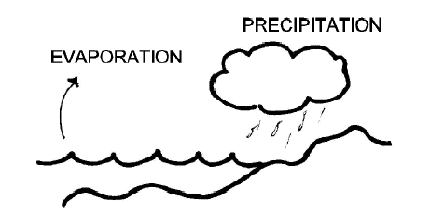BACKGROUND:
The Earth is made up of both land
and water. When water is heated it changes from liquid
to the gas (water vapor). This process is called evaporation.
When water vapor is cooled, the gas will go through condensation (change back to liquid form.)
When the drops become large they will precipitate as rain, snow,
sleet, or hail.
We can see water vapor condensing when we
watch clouds. A cloud is nothing more than water vapor that has
starting to condensate
back to a liquid form. A cloud is made of extremely tiny drops of
water which can remain suspended in the air. As a cloud grows, and
more and more water condense in the same place, the cloud droplets get
larger. Eventually, these cloud droplets will be too large to remain
in the air. The cloud is then said to be saturated. A saturated
cloud will usually precipitate its excess water, or cause it to fall.
This is how it rains or snows. Moisture falling from clouds is called
precipitation.
The amount of the gaseous water vapor that
is in the air tells us the relative humidity of the air. Humidity
is a measure of how moist or dry feeling the air is. When the air
is warm, it can hold more water vapor than when it is cold. When
the humidity is high, it is very difficult to dry off after swimming, since
there is so much moisture already in the air, it is not easy for more to
evaporate. When the humidity is low, dry air easily evaporates water.
The cycle of evaporation, condensation, and
precipitation of water is called the water or hydrologic cycle.
Since clouds move across the sky, the precipitation does not usually fall
in the same place that the water came from. This is how the earth
spreads water across land areas and allow us to live in so many different
areas.
PROCEDURE:
-
Discuss the water cycle.
Make sure you explain the vocabulary by pointing out their position in
the water cycle. Discuss with students the different types of condensation,
evaporation, and precipitation. Condensation is the process by which
gases become liquid. Water vapor in the air condenses into tiny drops.
Examples include fog and clouds. Precipitation is water which
condenses from water vapor. Precipitation falls to the Earth as rain,
snow, sleet, and hail. Evaporation is the process by which liquid
becomes gas. For example, vapors that rise from the ground on a hot
day or when a puddle dries after a rainstorm. Students may confuse
smoke with clouds. Smoke consists of particles of substances
like oil, wood, coal, but not water. Clouds, fog, and water vapor
are exclusively water.

-
Give the students the worksheet and
have them define each of the terms after they read or sing Drippy the Hippie.
The pictures should give them
“clues” on how to define each of the terms.